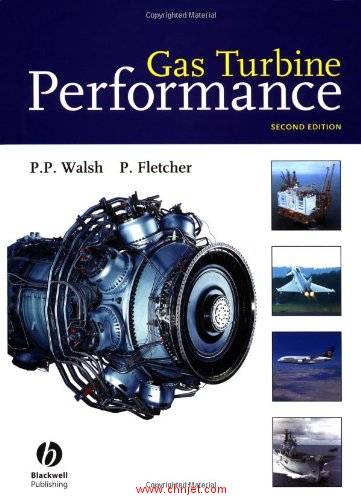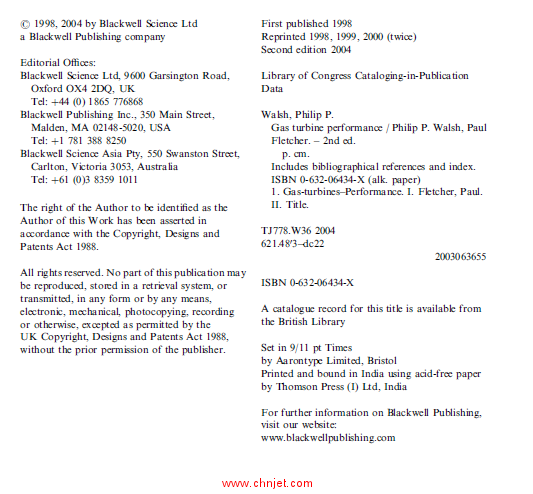马上注册,结交更多好友,享用更多功能,让你轻松玩转社区。
您需要 登录 才可以下载或查看,没有账号?立即注册


x
《Gas Turbine Performance》第二版
燃气轮机性能
作者:
Philip P. Walsh
BSc, FRAeS, CEng
Head of Performance and Engine Systems
Rolls-Royce plc
Paul Fletcher
MA (Oxon), MRAeS, CEng
Manager, Prelim Design
Energy Business
Rolls-Royce plc
出版社:Blackwell Science
出版时间:2004年
《Gas Turbine Performance》第二版

《Gas Turbine Performance》第二版

《Gas Turbine Performance》第二版

《Gas Turbine Performance》第二版

目录 1 Gas Turbine Engine Applications.
1.0 Introduction.
1.1 Comparison of gas turbine and high speed diesel engines.
1.2 Power generation applications.
1.3 Industrial mechanical drive applications.
1.4 Automotive applications.
1.5 Marine applications.
1.6 Aircraft applications - propulsion requirements.
1.7 Shaft powered aircraft - turboprops and turboshafts.
1.8 Thrust propelled aircraft - turbofans, turbojets and ramjets.
1.9 Auxiliary power units (APUs).
Formulae.
Sample calculations.
Charts.
References.
2 The Operational Envelope.
2.0 Introduction.
2.1 The environmental envelope.
2.2 Installation pressure losses.
2.3 The flight envelope.
Formulae.
Sample calculations.
Charts.
References.
3 Properties and Charts for Dry Air, Combustion Products and other Working Fluids.
3.0 Introduction.
3.1 Description of fundamental gas properties.
3.2 Description of key thermodynamic parameters.
3.3 Composition of dry air an combustion products.
3.4 The use of CP and gamma, or specific enthalpy and entropy, in calculations.
3.5 Data base for fundamental and thermodynamic gas properties.
3.6 Charts showing interrelationships of key thermodynamic parameters.
Formulae.
Sample calculations.
Charts.
References.
4 Dimensionless, Quasidimensionless, Referred and Scaling Parameter Group.
4.0 Introduction.
4.1 The importance of parameter groups.
4.2 Tables of parameter groups and description.
4.3 Examples of applications.
4.4 Second-order effects - steady state performance.
4.5 Second-order effects - engines scaling.
4.6 Second-order effects - transient performance.
4.7 Why components and engines adhere to the parameter group relationships.
Sample calculations.
Charts.
References.
5 Gas Turbine Engine Components.
5.0 Introduction.
5.1 Axial compressors - design point performance and basic sizing.
5.2 Axial flow - off design performance.
5.3 Centrifugal compressors - design point performance and basic sizing.
5.4 Centrifugal compressors - off design performance.
5.5 Fans - design point performance and basic sizing.
5.6 Fans - off design performance.
5.7 Combustors - design point performance and basic sizing.
5.8 Combustors - off design performance.
5.9 Axial flow turbines - design point performance and basic sizing guidelines.
5.10 Axial flow turbines - off design performance.
5.11 Radial turbines - design.
5.12 Radial turbines - off design performance.
5.13 Ducts - design.
5.14 Ducts - off design performance.
5.15 Air systems, turbines NGV and blade cooling - design point performance.
5.16 Air systems - off design performance.
5.17 Mechanical losses - design point performance and basic sizing.
5.18 Mechanical losses - off design performance.
5.19 Mixers - design point performance and basic sizing.
5.20 Mixers - off design performance.
5.21 Afterburners - design point performance and basic sizing.
5.22 Afterburners - off design performance.
5.23 Heat exchangers - design point performance and basic sizing.
5.24 Heat exchangers - off design performance.
5.25 Alternators - design point performance.
5.26 Alternators - off design performance.
Formulae.
Sample calculations.
Charts.
References.
6 Design Point Performance and Engine Concept Design.
6.0 Introduction.
6.1 Design point and off design performance calculations.
6.2 Design point performance parameters.
6.3 Design point calculation and diagram.
6.4 Linearly scaling components and engines.
6.5 Design point exchange rates.
6.6 Ground rules for generic design point diagrams.
6.7 Open shaft power cycles: generic design point diagrams and exchange rates.
6.8 Combined heat and power: generic design point diagrams and exchange rates.
6.9 Closed cycles: generic design point diagrams and exchange rates.
6.10 Aircraft engines shaft power cycles: generic design point diagrams and exchange rates.
6.11 Aircraft engine thrust cycles: generic design point diagrams and exchange rates.
6.12 The engine concept design process.
6.13 Margins required when specifying target performance levels.
Formulae.
Sample calculations.
Charts.
References.
7 Off Design Performance.
7.0 Introduction.
7.1 Generic off design characteristics.
7.2 Off design performance modelling - methodology.
7.3 Off design performance modelling - flow diagrams and sample calculations.
7.4 Geometric variation: modelling and effects.
7.5 Engine scaling and different working fluids.
7.6 Off design matching: physical mechanisms.
7.7 Exchange rates.
7.8 Ratings and control.
Formulae.
Sample calculations.
Charts.
References.
8 Transient Performance.
8.0 Introduction.
8.1 The fundamental transient mechanism.
8.2 Transient performance manoeuvres.
8.3 Engine accel and decel requirements.
8.4 Transient performance phenomena.
8.5 Operability concerns.
8.6 Surge, rotating stall and locked stall - the events and their detection.
8.7 Surge margin requirements and the surge margin stack up.
8.8 Parameter groups and transient performance.
8.9 Scaling parameter groups and transient performance.
8.10 Control strategies during transient manoeuvres.
8.11 Transient performance and control models.
Formulae.
Sample calculations.
References.
9 Starting.
9.0 Introduction.
9.1 The fundamental starting process.
9.2 Start processes for major engine types and applications.
9.3 Engine start requirements.
9.4 The impact of ambient temperature and pressure.
9.5 Operability issues.
9.6 Starting and parameter groups.
9.7 Control Strategies and parameter groups.
9.8 Starter system variants and selection.
9.9 Start and control models.
Formulae.
Sample calculations.
References.
10 Windmilling.
10.0 Introduction.
10.1 Turbojet windmilling.
10.2 Turbofan windmilling.
10.3 Turboprop windmilling.
10.4 Industrial engine windmilling.
10.5 Marine engine windmilling.
10.6 The effect of ambient conditions.
10.7 Scaling an engine.
10.8 Windmill testing.
10.9 Windmill computer modelling.
Formulae.
Sample calculations.
Charts.
References.
11 Engine Performance Testing.
11.0 Introduction.
11.1 Types of engine test bed.
11.2 Measurements and instrumentation.
11.3 Test bed calibration.
11.4 Steady state development testing.
11.5 Transient development testing.
11.6 Application testing.
11.7 Production pass off.
11.8 Test data analysis.
Formulae.
Sample calculations.
References.
12 The Effects of Water - Liquid, Stream and Ice.
12.0 Introduction.
12.1 Gas properties.
12.2 Humidity.
12.3 Water injection.
12.4 Steam injection.
12.5 Condensation.
12.6 Rain and ice ingestion.
12.7 The thermodynamics of water.
12.8 Gas turbine performance modelling and test data analysis.
Formulae.
Sample calculations.
Charts.
References.
13 Fuel and Oil Properties and their Impact.
13.0 Introduction.
13.1 The combustion process and gas turbine fuel types.
13.2 Data base of key fuel properties for performance calculations.
13.3 Synthesis exchange rates for primary fuel types.
13.4 Oil types and data base of key properties.
Formulae.
Sample calculations.
Charts.
References.
14 Performance of In-service Products.
15 Performance and the Economics of Gas Turbine Engines.
Appendix A: Station Numbering and Nomenclature.
A.0 Introduction.
A.1 International station numbering and nomenclature standards.
A.2 ARP 755A station numbering.
A.3 Nomenclature.
A.4 Customer deck requirements.
References.
Appendix B: Unit Conversions.
B.0 Introduction.
B.1 Acceleration.
B.2 Area.
B.3 Density.
B.4 Energy.
B.5 Force.
B.6 Fuel consumption.
B.7 Length.
B.8 Mass.
B.9 Moment of inertia.
B.10 Momentum - angular.
B.11 Momentum - linear.
B.12 Power.
B.13 Pressure.
B.14 Specific energy.
B.15 Specific fuel consumption (SFC)
专业书籍
下载地址:(回复后可见)
| ![]()
![]()